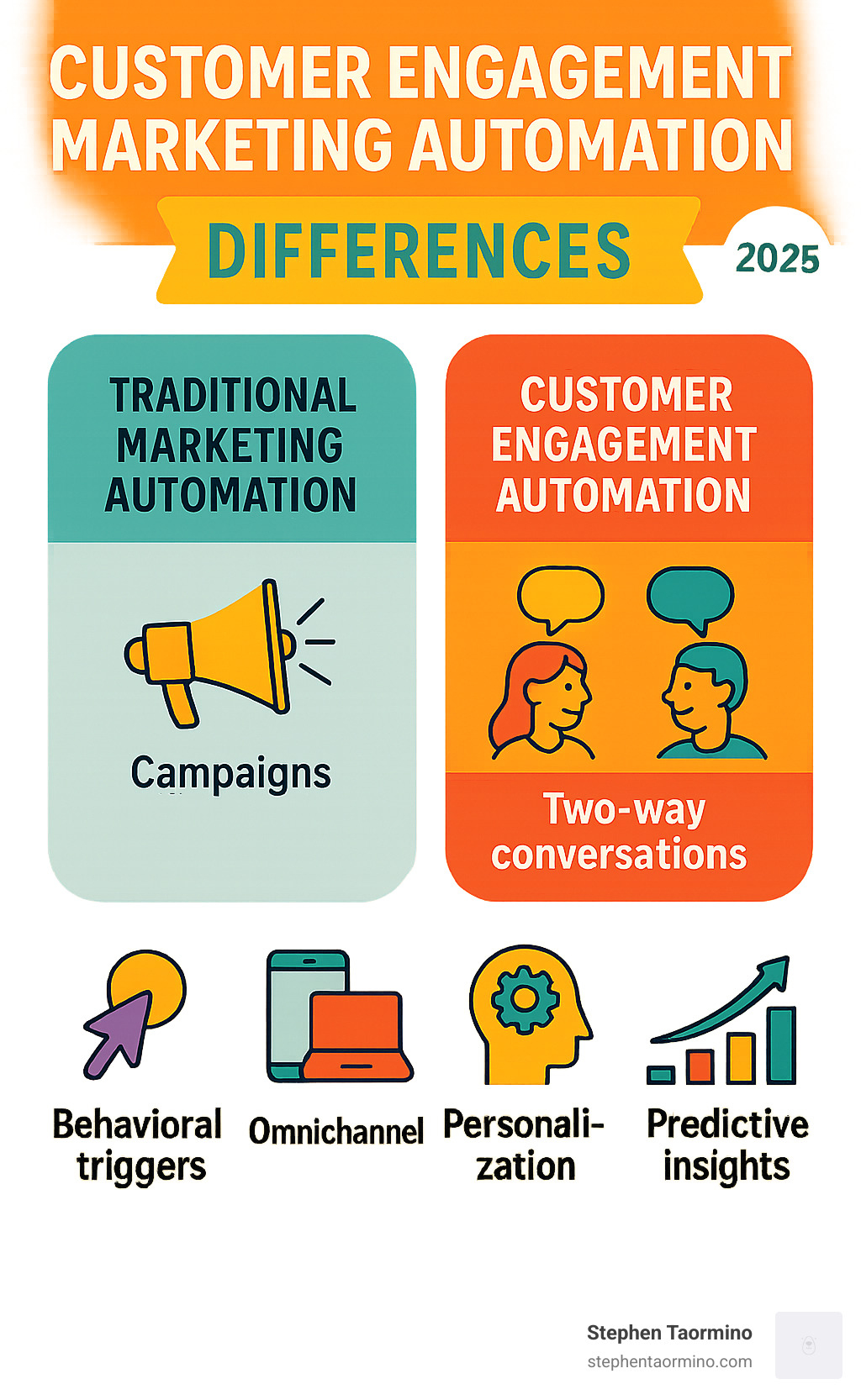Customer engagement marketing automation: Elevate in 2025
Why Customer Engagement Marketing Automation is Essential for Modern Business Growth
Customer engagement marketing automation is the strategic use of technology to deliver personalized, timely interactions that build meaningful relationships across the entire customer lifecycle. Unlike traditional automation focused on campaigns, this approach creates emotional connections by responding to real-time customer behavior. It relies on key components like behavioral triggers, omnichannel orchestration, real-time personalization, and predictive analytics to create two-way conversations that adapt to each customer’s unique journey.
The stakes are high. With 80% of customers valuing their experience as much as the product itself, personalized communication has become a key factor in brand consideration. Companies that master this approach report significant increases in conversions and customer retention.

I’m Steve Taormino, and for over 25 years, I’ve helped organizations implement customer engagement strategies that blend marketing psychology with technology. My focus is on creating automated systems that feel genuinely personal, drive measurable growth, and build lasting customer loyalty. For foundational principles that inform this approach, explore our Marketing Psychology Insights.
What is Customer Engagement Automation and Why Does It Matter?
Customer engagement marketing automation blends human understanding with technological precision to create meaningful moments that turn customers into advocates. While traditional automation streamlines tasks, this approach builds relationships. Instead of broadcasting generic messages, it facilitates personalized conversations at scale, making each customer feel seen and valued.
This shift is critical because customer expectations have changed. When research shows that 76% of consumers consider personalized communications a key factor in brand consideration, generic marketing is no longer effective. The power of this approach lies in its ability to scale genuine human connection, delivering a consistent, personal touch that builds trust and emotional connections.
The Core Benefits of Automating Customer Engagement

Adopting customer engagement marketing automation delivers tangible results that drive growth.
- Increased Efficiency: Frees your team from repetitive tasks to focus on strategy and creativity, reducing marketing overhead.
- Higher Conversions: Delivers the right message at the right moment. Companies report nearly 80% increased conversions from targeted automation.
- Improved Customer Retention: Nurtures the emotional connections that build loyalty. Engaged customers stay longer and become advocates.
- Data-Driven Decisions: Generates actionable insights from every interaction, allowing you to refine your strategy based on real behavior.
- Personalization at Scale: Tailors experiences to individual preferences, strengthening connections and driving better business outcomes.
- Stronger Brand Image: Builds trust through consistent, thoughtful interactions that reinforce your brand promise.
For deeper insights on maximizing returns, explore our guide on Marketing ROI Best Practices.
Key Differences from Traditional Marketing Automation
The evolution to customer engagement marketing automation is a shift from a loudspeaker to a conversation. While both communicate, only one builds lasting relationships.
| Feature | Traditional Marketing Automation | Customer Engagement Automation |
|---|---|---|
| Primary Focus | Campaign-centric (lead nurturing) | Customer-centric (relationship building) |
| Interaction Flow | Linear, one-way communication | Dynamic, two-way conversations |
| Trigger Basis | Pre-defined schedules, simple actions | Real-time behavior, complex events |
| Data Usage | Segmentation, basic personalization | Hyper-personalization, predictive insights |
| Channel Approach | Often siloed (e.g., email-only) | Omnichannel, integrated experiences |
| Goal | Lead conversion, efficiency | Retention, loyalty, lifetime value |
Traditional automation is effective for moving prospects through a predefined funnel. Customer engagement automation, however, focuses on the complete customer lifecycle. It uses an omnichannel approach to create seamless experiences across all touchpoints and leverages real-time responsiveness to react instantly to customer behavior. This creates marketing that feels less like marketing and more like helpful, personalized service.
A Strategic Blueprint for Implementing Customer Engagement Marketing Automation
Building a successful customer engagement marketing automation strategy requires a roadmap that evolves with your customers. The most effective implementations begin with clear goals and a deep understanding of human behavior.
Start with SMART goals to give your strategy direction, such as “reduce customer churn by 15% in six months.” Then, use customer journey mapping to detail every interaction a customer has with your brand, identifying opportunities for automation. These behavioral triggers—like repeat page visits or app inactivity—tell you when to engage. Continuously use A/B testing to optimize every element, from subject lines to timing. The key is to start small and scale smart: master one journey, measure its impact, and then expand. For more on this, see our B2B Marketing Strategies to Optimize Sales Conversions.
The Central Role of Data and Analytics
In today’s privacy-focused world, first-party data—information customers willingly share—is your most valuable asset. The phase-out of third-party cookies has forced marketers to build more authentic relationships by focusing on this data.
Use this information for customer segmentation, creating meaningful groups based on behavior and preferences. This allows automation to feel personal, not robotic. Behavioral data reveals the story behind the numbers, fueling intelligent automation that responds to what customers actually want. Predictive analytics takes this further, using historical patterns to anticipate future needs, such as identifying customers at risk of churning. A strong Customer Engagement Analytics Platform is essential for turning these insights into action.
Key Strategies for customer engagement marketing automation
Successful automation strategies feel effortless to the customer while working tirelessly behind the scenes.
- Personalized Onboarding: Deliver relevant guidance based on a new user’s specific goals and initial actions to increase early engagement.
- Behavioral-Triggered Communications: Respond automatically to cart abandonment, product views, or inactivity with relevant, helpful content.
- Proactive Support with Chatbots: Use AI assistants to recognize frustration, offer contextual help, and escalate complex issues to human agents.
- Automated Loyalty Programs: Intelligently reward valuable customer behaviors—from purchases to referrals—to make customers feel appreciated.
- Re-engagement Campaigns: Nurture inactive users with value-driven content or feedback requests rather than just sales messages.
These strategies work best when they feel like natural extensions of your brand. For more on the principles behind them, explore Behavioral Economics Marketing Techniques.
Measuring the Success of Your customer engagement marketing automation
Measuring impact goes beyond opens and clicks. Focus on metrics that tell the story of relationship strength and business growth.
- Customer Lifetime Value (CLV): Your north star metric. Effective automation increases how long customers stay and how much they spend.
- Churn Rate: A declining churn rate indicates your automated touchpoints are successfully addressing customer needs.
- Net Promoter Score (NPS): Measures the quality of the relationships you’re building. Helpful, personal automation turns customers into advocates.
- Conversion Rates: Track micro-conversions (e.g., content downloads) and macro-conversions (e.g., purchases) to see what resonates.
- Engagement Metrics: Look beyond email stats to app usage and content consumption to refine your automation triggers.
Connecting these metrics to business outcomes with Digital Marketing ROI Measurement Tools transforms automation from an expense into a strategic investment.
The Future of Engagement: AI, Personalization, and What’s Next

The future of customer engagement marketing automation is here, with artificial intelligence and machine learning becoming the backbone of how we connect with customers. We are moving beyond simple rule-based automation to predictive systems that anticipate customer needs. With 45% of organizations believing AI will reshape their customer experience within five years (source: Statista), the time to adapt is now.
This evolution enables hyper-personalization at scale, creating millions of unique, individual experiences simultaneously. The goal isn’t to replace the human touch but to amplify it, using intelligent technology to be more relevant and helpful at every touchpoint.
How AI is Reshaping Customer Engagement
AI is making customer engagement marketing automation smarter and more intuitive. Here’s how:
- AI-Powered Chatbots: Modern chatbots hold contextual conversations, understand emotional cues, and seamlessly escalate issues to human agents when necessary.
- Natural Language Processing (NLP): This technology allows systems to understand customer sentiment in reviews, social media, and support tickets, providing deep insights quickly.
- Predictive Analytics for Churn: AI can spot early warning signs of customer churn, automatically triggering retention campaigns or alerting your team to reach out personally.
- Real-time Content Personalization: Websites and apps can now reconfigure themselves for each visitor based on their behavior, preferences, and history, creating a highly relevant experience.
- AI-Driven Journey Orchestration: The system determines the optimal channel, timing, and message for each interaction, creating seamless, intelligent customer journeys.
These capabilities are improved by Marketing Psychology Insights, which help us understand the ‘why’ behind customer actions. To stay competitive, explore AI-Driven Customer Engagement Solutions.
Preparing for Upcoming Digital Marketing Industry Trends
Adapting to the evolving digital landscape is crucial. Key trends include:
- Omnichannel Consistency: Customers expect a unified experience across all channels. Your automation must ensure conversations and preferences travel with the customer from social media to email to your website.
- Data Privacy and Trust: Be transparent about data collection and give customers control. Use data to provide clear value in return, building trust as a competitive advantage.
- First-Party Data Strategy: With the decline of third-party cookies, mastering the collection and activation of your own customer data is essential for accurate and effective personalization.
- Voice and Conversational AI: As smart speakers become more common, voice-activated service and shopping create new, more natural ways to interact with your brand.
Businesses that thrive will be those that thoughtfully adopt innovations that genuinely improve the customer experience. Stay informed on these Digital Marketing Industry Trends to keep your strategies relevant and effective.
Frequently Asked Questions about Customer Engagement Automation
As a consultant and speaker, I often hear the same questions from leaders eager to leverage customer engagement marketing automation. Here are practical answers to the most common concerns.
What are the first steps to get started with customer engagement automation?
Start small and be strategic. Don’t try to automate everything at once.
- Define One Clear Goal: Focus on a specific pain point, like reducing cart abandonment or improving new user onboarding.
- Map a Single Customer Journey: Trace the steps related to your goal to identify friction points and opportunities for automation.
- Choose a Foundational Tool: You don’t need a massive platform to start. A simple email automation tool or chatbot can deliver significant results.
- Measure and Expand: Launch your first sequence, track its performance, and use that data to inform your next initiative.
Can small businesses benefit from customer engagement automation?
Yes, absolutely. Small businesses often see the most dramatic benefits from automation because it allows them to scale personal engagement without a large team. Modern tools are cost-effective, with many offering free or affordable entry-level plans. By focusing on high-impact areas like lead nurturing and customer onboarding, a small business can compete with larger players by providing a superior, personalized customer experience.
How does automation improve customer retention and loyalty?
Automation builds loyalty by enabling you to show care and understanding at scale. It works by:
- Personalizing Communication: Using data to make every customer feel seen and understood.
- Providing Timely Support: Offering instant help through chatbots and automated resources, which builds trust and reliability.
- Enabling Proactive Outreach: Anticipating customer needs, such as reorder reminders or check-ins for inactive users, shows you value the relationship beyond the sale.
- Ensuring a Consistent Experience: Reinforcing your brand promise at every touchpoint, which builds confidence and long-term trust.
Conclusion
The shift to customer engagement marketing automation is more than a technological upgrade; it’s a fundamental change in how businesses build relationships. The key takeaway is that success lies in combining technology with a human-centric strategy. By using behavioral triggers, omnichannel consistency, and real-time personalization, you can build meaningful connections at scale.
My work in marketing psychology confirms that the most effective automation understands why people act. When we automate with empathy, we create experiences that feel personal, driving growth and turning customers into advocates. Companies using this approach are seeing dramatic increases in conversions and retention because they’ve stopped pushing messages and started having conversations.
The future is engaged. AI-driven personalization and predictive analytics are today’s competitive advantages. To succeed, brands must accept these tools without losing sight of the human element.
Customer engagement automation is an ongoing journey of learning and optimization. Start small, measure your results, and always keep the customer at the center of your strategy. To truly lift your brand and build lasting relationships, automation is essential.
Ready to transform your customer relationships? Explore comprehensive Customer Engagement Solutions and find how the right strategy can deepen connection and loyalty.
